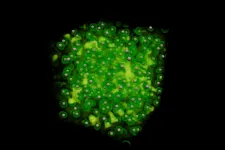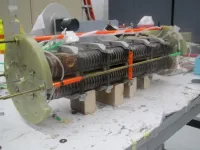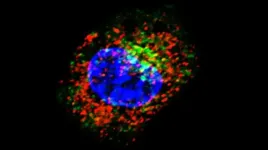(Press-News.org) Tiny molecular forces at the surface of water droplets can play a big role in laser output emissions. As the most fundamental matrix of life, water drives numerous essential biological activities, through interactions with biomolecules and organisms. Studying the mechanical effects of water-involved interactions contributes to the understanding of biochemical processes. According to Yu-Cheng Chen, professor of electronic engineering at Nanyang Technological University (NTU), "As water interacts with a surface, the hydrophobicity at the bio-interface mainly determines the mechanical equilibrium of the water. Molecular hydrophobicity at the interface can serve as the basis for monitoring subtle biomolecular interactions and dynamics."
Water droplets have been used to form biological microlasers that exploit water's intrinsic ability to confine light with minimal scattering. Droplet lasers benefit from laser oscillation in a microcavity, so any subtle changes induced by the gain medium or cavity can be amplified, leading to dramatic changes of laser emission characteristics. While droplet lasers have become cutting-edge platforms in biochemical/physical studies and biomedical applications, the optical interaction between droplet resonators and an interface has remained unknown.
Lasing mechanism found in water droplets
Lasing mechanism at the surface of water droplets can be used to record mechanical changes at biointerfaces
2021-01-28
ELSE PRESS RELEASES FROM THIS DATE:
Thick lithosphere casts doubt on plate tectonics in Venus's geologically recent past
2021-01-28
PROVIDENCE, R.I. [Brown University] -- At some point between 300 million and 1 billion years ago, a large cosmic object smashed into the planet Venus, leaving a crater more than 170 miles in diameter. A team of Brown University researchers has used that ancient impact scar to explore the possibility that Venus once had Earth-like plate tectonics.
For a study published in Nature Astronomy, the researchers used computer models to recreate the impact that carved out Mead crater, Venus's largest impact basin. Mead is surrounded by two clifflike faults -- rocky ripples frozen in time after the basin-forming impact. The models showed that for those rings to be where they ...
Post-overdose outreach programs in Massachusetts expanding
2021-01-28
BOSTON-Boston Medical Center has released a study that shows post overdose outreach programs in Massachusetts have expanded across the state, as 44 percent of municipalities reported having such programs available - a majority established since 2015 - to reduce risks for those who survive an overdose. The results are published online in the February 2021 issue of Drug and Alcohol Dependence.
These post-overdose outreach programs leverage collaborations between public health overdose prevention practitioners and public safety organizations (police, fire, EMS) to engage overdose survivors and/or their social networks (family, friends, and acquaintances) at their home one to three days after an overdose. ...
Breakthrough for laser-induced breakdown spectroscopy
2021-01-28
Laser-induced breakdown spectroscopy (LIBS) is a rapid chemical analysis tool. A powerful laser pulse is focused on a sample to create a microplasma. The elemental or molecular emission spectra from that microplasma can be used to determine the elemental composition of the sample.
Compared with more traditional technology, like atomic absorption spectroscopy and inductively coupled plasma optical emission spectroscopy (ICP-OES), LIBS has some unique advantages: no sample pretreatment, simultaneous multi-element detection, and real-time noncontact measurements. These advantages make it suitable for practical analysis of solids, gases, and liquids.
Traditional LIBS and extensions
Traditional ...
Harnessing the power of AI to understand warm dense matter
2021-01-28
The study of warm dense matter helps us understand what is going on inside giant planets, brown dwarfs, and neutron stars. However, this state of matter, which exhibits properties of both solids and plasmas, does not occur naturally on Earth. It can be produced artificially in the lab using large X-ray experiments, albeit only at a small scale and for short periods of time. Theoretical and numerical models are essential to evaluate these experiments, which are impossible to interpret without formulas, algorithms, and simulations. Scientists at the Center for Advanced Systems Understanding (CASUS) at the Helmholtz-Zentrum Dresden-Rossendorf (HZDR) have now developed a method to evaluate such ...
National laboratories' look to the future of light sources with new magnet prototype
2021-01-28
With a powerful enough light, you can see things that people once thought would be impossible. Large-scale light source facilities generate that powerful light, and scientists use it to create more durable materials, build more efficient batteries and computers, and learn more about the natural world.
When it comes to building these massive facilities, space is money. If you can get higher-energy beams of light out of smaller devices, you can save millions on construction costs. Add to that the chance to significantly improve the capabilities of existing light sources, and you have the motivation behind a project that has brought scientists at three U.S. Department of Energy national laboratories together.
This team has just achieved an important milestone ...
Genetic analysis of symptoms yields new insights into PTSD
2021-01-28
Attempts to identify the genetic causes of neuropsychiatric diseases such as post-traumatic stress disorder (PTSD) through large-scale genome-wide analyses have yielded thousands of potential links. The challenge is further complicated by the wide range of symptoms exhibited by those who have PTSD. For instance, does extreme arousal, anger, or irritation experienced by some have the same genetic basis as the tendency to re-experience traumatic events, another symptom of the disorder?
A new study led by researchers at Yale and the University of California-San Diego (UCSD) provides answers to some of these questions and uncovers intriguing genetic similarities between PTSD and other mental health disorders such as anxiety, bipolar disorder, and schizophrenia. ...
At-home swabs diagnose infections as accurately as healthcare worker-collected swabs
2021-01-28
Washington, DC - January 28, 2021 - Self swabs and caregiver swabs are effective at detecting multiple pathogens and are just as accurate as those taken by healthcare workers, according to a team of Australian researchers. The research appears in the Journal of Clinical Microbiology, a publication of the American Society for Microbiology.
"Across the range of pathogens and swab types, there was high agreement between results from self- or caregiver swabs and those performed by a healthcare worker, even when different sites were swabbed (e.g. nasopharyngeal vs. nasal)," said principal investigator Joshua Osowicki, BMedSci, MBBS, FRACP, a Pediatric Infectious Diseases physician in the Murdoch Children's Research Institute's ...
Modeling study of ancient thumbs traces the history of hominin thumb dexterity
2021-01-28
Despite long-standing ideas about the importance of thumb evolution in tool use and development, questions remain about exactly when human-like manual dexterity and efficient thumb use arose--and which hominin species was the first to have this ability. Now, researchers who've analyzed the biomechanics and efficiency of the thumb across different fossil human species using virtual muscle modeling have new insight into when these abilities first arose and what they've meant for the development of more complex human culture. The findings, appearing January 28 in the journal Current Biology, suggest that a fundamental aspect of human thumb opposition first appeared approximately 2 million years ago and was not found ...
Risk-taking behavior has a signature in the brain, big data shows
2021-01-28
What makes one person drive above the speed limit while another navigates steadily in the right lane? What motivates someone to leave a job with a steady paycheck to launch their own business while the other sticks to one employer for an entire career?
"People have different tendencies to engage in behavior that risks their health or that involve uncertainties about the future," says Gideon Nave, an assistant professor of marketing in Penn's Wharton School.
Yet explaining the origin of those tendencies, both in the genome and in the brain, has been challenging for researchers, partly because previous studies on ...
How a little-known glycoprotein blocks a cancer cell's immune response
2021-01-28
ANN ARBOR, Michigan -- It was an unexpected discovery that started with an analysis of more than 1,000 genes. The question: why game-changing cancer immunotherapy treatments work for only a fraction of patients.
The analysis shone a light on one that popped up repeatedly in patients and mouse models that did not respond to immune checkpoint therapy: stanniocalcin-1, a glycoprotein whose role in both tumors and immunology is largely unknown.
By following the trail from this surprising thread, a University of Michigan Rogel Cancer team uncovered how stanniocalcin-1, or STC1, works inside the cell to block a cellular "eat-me" signal that typically triggers the immune system to produce T cells to fight the tumor. The findings, published in ...
LAST 30 PRESS RELEASES:
Interaction of climate change and human activity and its impact on plant diversity in Qinghai-Tibet plateau
From addressing uncertainty to national strategy: an interpretation of Professor Lim Siong Guan’s views
Clinical trials on AI language model use in digestive healthcare
Scientists improve robotic visual–inertial trajectory localization accuracy using cross-modal interaction and selection techniques
Correlation between cancer cachexia and immune-related adverse events in HCC
Human adipose tissue: a new source for functional organoids
Metro lines double as freight highways during off-peak hours, Beijing study shows
Biomedical functions and applications of nanomaterials in tumor diagnosis and treatment: perspectives from ophthalmic oncology
3D imaging unveils how passivation improves perovskite solar cell performance
Enriching framework Al sites in 8-membered rings of Cu-SSZ-39 zeolite to enhance low-temperature ammonia selective catalytic reduction performance
AI-powered RNA drug development: a new frontier in therapeutics
Decoupling the HOR enhancement on PtRu: Dynamically matching interfacial water to reaction coordinates
Sulfur isn’t poisonous when it synergistically acts with phosphine in olefins hydroformylation
URI researchers uncover molecular mechanisms behind speciation in corals
Chitin based carbon aerogel offers a cleaner way to store thermal energy
Tracing hidden sources of nitrate pollution in rapidly changing rural urban landscapes
Viruses on plastic pollution may quietly accelerate the spread of antibiotic resistance
Three UH Rainbow Babies & Children’s faculty elected to prestigious American Pediatric Society
Tunnel resilience models unveiled to aid post-earthquake recovery
Satellite communication systems: the future of 5G/6G connectivity
Space computing power networks: a new frontier for satellite technologies
Experiments advance potential of protein that makes hydrogen sulfide as a therapeutic target for Alzheimer’s disease
Examining private equity’s role in fertility care
Current Molecular Pharmacology achieves a landmark: real-time CiteScore advances to 7.2
Skeletal muscle epigenetic clocks developed using postmortem tissue from an Asian population
Estimating unemployment rates with social media data
Climate policies can backfire by eroding “green” values, study finds
Too much screen time too soon? A*STAR study links infant screen exposure to brain changes and teen anxiety
Global psychiatry mourns Professor Dan Stein, visionary who transformed mental health science across Africa and beyond
KIST develops eco-friendly palladium recovery technology to safeguard resource security
[Press-News.org] Lasing mechanism found in water dropletsLasing mechanism at the surface of water droplets can be used to record mechanical changes at biointerfaces





